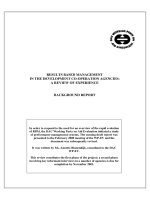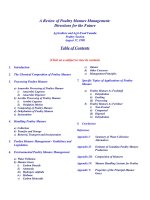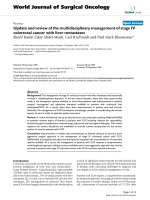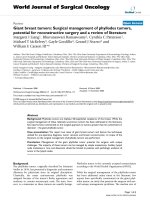Lecture 17 review of requirements management
Bạn đang xem bản rút gọn của tài liệu. Xem và tải ngay bản đầy đủ của tài liệu tại đây (1.18 MB, 32 trang )
Requirements Engineering
Review of Requirements
Management
John Vu
Senior Scientist
Institute for Software Research
Carnegie Mellon University
Review Requirements Management
Always continually assess your requirements
engineering practices once the requirement
process begins, by periodically stopping your
work to examine practices and deliverables to
indentify improvement opportunities.
Ask team members which requirements practices
work and which ones do not work, making
modifications to the process.
Conduct a requirements process review at the
end of each iteration to ensure quality work and
additional improvement opportunities.
Review is the time to acquire and use lessons
learned to improve.
© John Vu - CMU-ISR
2
Software Is A Risky Business
© John Vu - CMU-ISR
3
The Effect On Business
© John Vu - CMU-ISR
4
Root Causes
© John Vu - CMU-ISR
5
Primary Root Cause - 1
© John Vu - CMU-ISR
6
Primary Root Cause - 2
© John Vu - CMU-ISR
7
A Team Efforts
© John Vu - CMU-ISR
8
Requirements Models
Requirements models can:
• Facilitate better communication between
technical and non-technical people.
• Allow stakeholders to view different aspects of
the requirements.
• Uncover missing, erroneous and vague
requirements.
• Make requirements more interesting by using
textual description and visual models to clarify
requirements.
ã Improve stakeholders involvement.
â John Vu - CMU-ISR
9
Model Progression
Product
© John Vu - CMU-ISR
10
Model Progression
Product
© John Vu - CMU-ISR
11
Analyze System Behavior
© John Vu - CMU-ISR
12
Analysis & Design - 1
Model
© John Vu - CMU-ISR
13
Analysis & Design - 2
© John Vu - CMU-ISR
14
Model Progression: Test
© John Vu - CMU-ISR
15
Requirements Engineering
A systematic approach to eliciting,
organizing, and documenting the
requirements of the system, and a process
that manages the changing requirements
of the system.
© John Vu - CMU-ISR
16
What Are We Managing?
© John Vu - CMU-ISR
17
What Do We Need?
In order to manage requirements we
need:
• Skills to elicit requirements from users and
stakeholders of the system.
• Tools and methods to organize the
requirements.
• Documentation to support communication of
the requirements.
© John Vu - CMU-ISR
18
Skills
© John Vu - CMU-ISR
19
Methods & Tools
Defining a Process
Organizing Requirements
Establishing Requirements Traceability
Change History
Tools and Tools Integration
© John Vu - CMU-ISR
20
Defining A Process
© John Vu - CMU-ISR
21
Organizing Requirements
© John Vu - CMU-ISR
22
Establishing Requirements Traceability
© John Vu - CMU-ISR
23
Change History
As requirements evolve, understand what
changed, when and why.
Version requirements and their associated
design and implementation artifacts.
Allow for change to be managed
incrementally.
© John Vu - CMU-ISR
24
Tools & Tool Integration
Organizing and establishing traceability
links requires some form of tool support.
Tools may be as simple as Excel
spreadsheets and Word documents.
But, projects of medium and large size will
be better served by more integrated tool
support.
© John Vu - CMU-ISR
25









